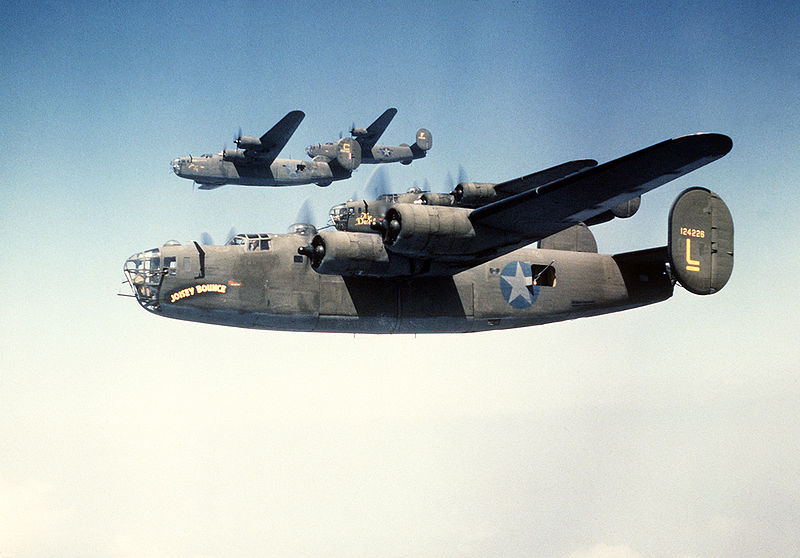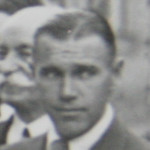
Consolidated B-24 Liberator
The Consolidated B-24 Liberator was an American heavy bomber, designed by Consolidated Aircraft of San Diego, California
About Consolidated B-24 Liberator – Source Wikipedia
Role: Heavy bomber
Manufacturer: Consolidated Aircraft
First flight: 29 December 1939
Introduction: 1941
Status: Retired 1968, Indian Air Force
Primary users: United States Army Air Forces, United States Navy, Royal Air Force, Royal Canadian Air Force
Number built: 18,482
Unit cost: US$297,627 ($4.7 million in today’s dollars)
Developed from:Consolidated XB-24
Variants: PB4Y Privateer, XB-41, C-87 Liberator Express, Consolidated R2Y, Consolidated Liberator I
Specifications (B-24J)
Data from Quest for Performance
General characteristics
- Crew: 11(pilot, co-pilot, navigator, bombardier, radio operator, chin turret, top turret, 2 waist gunners, ball turret, tail gunner)
- Length: 67 ft 8 in (20.6 m)
- Wingspan: 110 ft 0 in (33.5 m)
- Height: 18 ft 0 in (5.5 m)
- Wing area: 1,048 ft² (97.4 m²)
- Empty weight: 36,500 lb (16,590 kg)
- Loaded weight: 55,000 lb (25,000 kg)
- Max. takeoff weight: 65,000 lb (29,500 kg)
- Powerplant: 4 × Pratt & Whitney R-1830 turbosupercharged radial engines, 1,200 hp (900 kW) each
- Zero-lift drag coefficient: 0.0406
- Drag area: 42.54 ft² (3.95 m²)
- Aspect ratio: 11.55
Performance
- Maximum speed: 290 mph (250 kn, 470 km/h)
- Cruise speed: 215 mph (187 kn, 346 km/h)
- Stall speed: 95 mph (83 kn, 153 km/h)
- Range: 2,100 mi (1,800 nmi, 3,400 km)
- Feryy range> 3,700 mi (3,200 nmi, 6,000 km)
- Service ceiling: 28,000 ft (8,500 m)
- Rate of climb: 1,025 ft/min (5.2 m/s)
- Wing loading: 52.5 lb/ft² (256 kg/m²)
- Power/mass: 0.0873 hp/lb (144 W/kg)
- Lift-to-drag ratio: 12.9
Armament
- Guns: 10 × .50 caliber (12.7 mm) M2 Browning machine guns in 4 turrets and two waist positions
- Bombs:
– Short range (~400 mi): 8,000 lb (3,600 kg)
– Long range (~800 mi): 5,000 lb (2,300 kg)
– Very long range (~1,200 mi): 2,700 lb (1,200 kg)

Consolidated B-24 Liberator
The Consolidated B-24 Liberator was an American heavy bomber, designed by Consolidated Aircraft of San Diego, California
The Consolidated B-24 Liberator was an American heavy bomber, designed by Consolidated Aircraft of San Diego, California. It was known within the company as the Model 32, and a small number of early models were sold under the name LB-30, for Land Bomber. The B-24 was used in World War II by several Allied air forces and navies, and by every branch of the American armed forces during the war, attaining a distinguished war record with its operations in the Western European, Pacific, Mediterranean, and China-Burma-India Theaters.
Often compared with the better-known Boeing B-17 Flying Fortress, the B-24 was a more modern design with a higher top speed, greater range, and a heavier bomb load; however, it was also more difficult to fly, with heavy control forces and poor formation-flying characteristics. Popular opinion among aircrews and general staffs tended to favor the B-17’s rugged qualities above all other considerations in the European Theater.[3] The placement of the B-24’s fuel tanks throughout the upper fuselage and its lightweight construction, designed to increase range and optimize assembly line production, made the aircraft vulnerable to battle damage.[4] The B-24 was notorious among American aircrews for its tendency to catch fire. Moreover, its high fuselage-mounted “Davis wing” also meant it was dangerous to ditch or belly land, since the fuselage tended to break apart.[5] Nevertheless, the B-24 provided excellent service in a variety of roles thanks to its large payload and long range.
The B-24’s most infamous mission was the low-level strike against the Ploiești oil fields, in Romania on 1 August 1943, which turned into a disaster because the enemy was underestimated, fully alerted and attackers disorganized.[5]
The B-24 ended World War II as the most produced Allied heavy bomber in history, and the most produced American military aircraft at over 18,400 units, due largely to Henry Ford and the harnessing of American industry.[6] It still holds the distinction as the most-produced American military aircraft.
Development
The Liberator originated from a United States Army Air Corps (USAAC) request in 1938 for Consolidated to produce the B-17 under license. After company executives including President Reuben Fleet visited the Boeing factory in Seattle, Washington, Consolidated decided instead to submit a more modern design of its own.[7]
Design
The B-24’s spacious, slab-sided fuselage (which earned the aircraft the nickname “Flying Boxcar”)[15] was built around a central bomb bay with two compartments that could accommodate up to 8,000 lb (3,629 kg) of ordnance each. The bomb bay was divided into front and rear compartments and had a central catwalk just nine inches wide,[16] which was also the fuselage keel beam. A universal complaint arose over the extremely narrow catwalk. The aircraft was sometimes disparaged as “The Flying Coffin” because the only entry and exit from the bomber was in the rear and it was almost impossible for the flight crew and nose gunner to get from the flight deck to the rear when wearing parachutes. An unusual set of “roller-type” bomb bay doors, which operated very much like the movable enclosure of a rolltop desk, retracted into the fuselage, creating a minimum of aerodynamic drag to keep speed high over the target area.[17]
Like the B-17, the B-24 had an array of .50 caliber (12.7 mm) M2 Browning machine guns in the tail, belly, top, sides and nose to defend it from attacking enemy fighters. However, unlike the B-17, the ball turret could be retracted into the fuselage when not in use, a necessity given the low ground clearance of the fuselage. The ball turret first appeared on B-24Ds sometime in early 1943 but not before the early Ds had used tunnel guns and the Bendix remote controlled ventral turret, also used (unsuccessfully) on the initial B-17E examples and on some early B-25 Mitchell medium bombers. General use of the ball turrets by the U.S. would last until late July 1944 when performance gains outweighed the need for 360 degree belly defense. Bomber command Liberators generally dispensed with the belly turrets as unnecessary in areas where no enemy fighter presence would be found.
Prototypes
Consolidated finished the prototype, by then known as the XB-24, and had it ready for its first flight two days before the end of 1939. After initial testing, the XB-24 was found to be deficient in several areas. One major failure of the prototype was that it failed to meet the top speed requirements specified in the contract. As built, the XB-24 top speed was only 273 mph instead of the specified 311 mph. As a result, the mechanically supercharged Pratt & Whitney R-1830-33s were replaced with the turbo-supercharged R-1830s. Additionally, the tail span was widened by 2 feet (0.61 m) and the pitot-static probes were relocated from the wings to the fuselage. The XB-24 was then redesigned XB-24B—these changes became standard on all B-24’s built starting with the B-24C model.
The USAAC initially ordered seven YB-24s under CAC contract # 12464 in April 1939, but like the prototype these aircraft were being built by hand and were not considered combat ready. The first six YB-24 were released for direct purchase under CAC contract # F-677 on 9 November 1940. These aircraft were redesignated LB-30A. The seventh aircraft was used by Consolidated and the USAAC to test armor installations as well as self-sealing fuel tanks. Initially, these aircraft were to be given USAAC serials 39-618 to 39-687. Due to delays with the actual purchase, however, the serial numbers were changed to 40-696 to 40-702. When the RAF purchased the first 6 YB-24 aircraft, the serial numbers were reassigned to a later block of B-24Ds.
The RAF, like the USAAC, found the LB-30As unsuitable for combat and had them assigned to the transatlantic Ferry Service between Canada and Prestwick, Scotland. The aircraft were all modified in Montreal for non-combat use. Changes included the removal of all armaments, provision for passenger seating, and a revised cabin oxygen & heating system.

Consolidated B-24 Liberator
The Consolidated B-24 Liberator was an American heavy bomber, designed by Consolidated Aircraft of San Diego, California



















